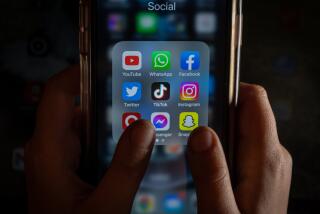Mobile phone radiation safety to be reviewed in U.S. by FCC
- Share via
The U.S. Federal Communications Commission plans to ask whether its standards protect humans from mobile-phone radiation, a question it hasn’t posed in 15 years, as people use smartphones for longer, more frequent calls.
Julius Genachowski, the agency’s chairman, is to ask fellow commissioners today to approve a notice commencing a formal inquiry, Tammy Sun, a spokeswoman for the agency, said in an emailed statement. The notice won’t propose rules, Sun said.
“Our action today is a routine review of our standards,” Sun said. “We are confident that, as set, the emissions guidelines for devices pose no risks to consumers.”
The FCC last updated its guidelines setting maximum radiation-exposure levels, which are based on the amount of heat emitted by mobile phones, in 1996.
“Any changes in the rules will have an impact on handset vendors,” said CW Cheung, the Asia-Pacific head of consulting for telecoms at Ovum, which advises companies in the telecommunications industry. “As most vendors are based outside the U.S., it could also become a trade issue.”
Samsung Electronics Co., based in Suwon, South Korea, was the world’s biggest vendor of mobile handsets in the first- quarter, according to research company Strategy Analytics. Finland’s Nokia Oyj ranked second, while Cupertino, California- based Apple Inc. was third, according to the researcher.
May Affect Brain
There have been concerns that radio-frequency energy from phones held close to the head may affect the brain and other tissues, according to the National Cancer Institute, part of the U.S. government’s National Institutes of Health. The cancer institute said on its website that studies of cells, animals and humans haven’t produced evidence that radiofrequency energy can cause cancer.
The number of mobile phone calls per day, the length of each call and the amount of time people use the phones have increased, and phone technology has also undergone substantial changes, the cancer institute said.
About 44 million people in the U.S. had mobile phones in 1996, according to FCC figures. There were 332 million wireless subscriber connections last year, according to CTIA-The Wireless Association, a trade group.
No Evidence
The weight of scientific evidence hasn’t effectively linked exposure to radio-frequency energy from mobile devices with health problems, according to the FCC’s website on wireless devices and health concerns.
The U.S. Food and Drug Administration found no evidence linking wireless phone use to heightened risk of brain tumors, according to its website. The agency examined a 2010 World Health Organization study and a separate program by the NCI that found no increase in brain cancer as mobile phone use increased.
Wireless devices emit energy when used, and the closer the device is to the body the more energy a person absorbs, the FCC said. People can reduce exposure by using a speakerphone or earpiece and increasing the distance between wireless devices and the body, the FCC said, without endorsing the need for such measures.
iPhone Guidance
Apple Inc. recommends that iPhone users carry the device at least 5 / 8inch (1.5 centimeters) from their bodies to keep exposure levels below the maximum levels. The iPhone meets FCC and European Union exposure guidelines, the Cupertino, California-based company said in a manual for the iPhone4s.
The city of San Francisco in 2010 required that stores post the level of radio waves emitted by each mobile phone they sell.
CTIA-The Wireless Association, a Washington-based trade group, challenged the requirement in court, saying it would mislead consumers about a safe product.
More research is needed into whether mobile-phone use harms people’s health, as a “growing number of experts” raise concern, U.S. Senator Tom Harkin, an Iowa Democrat, said at a hearing in 2009.
Some researchers believe the low level of radiation from mobile phones may cause cancers of the brain and central nervous system, said Harkin, chairman of an Appropriations subcommittee on health. He made the remarks at a panel hearing into mobile phones.
Unprecedented Levels
“We’re talking about cell phones that many of us are using all the time, and children are using in unprecedented levels, and we have never been exposed to this level in our lives,” Devra Lee Davis, at the time an epidemiology professor in the University of Pittsburgh’s School of Public Health, told the Harkin panel hearing in 2009.
Standards are set for “a very large, big man” and not for children, Davis said. The absence of definite epidemiological evidence isn’t proof that there’s not a problem and shows that not enough studies have been done, she said. Davis is founder and president of the Environmental Health Trust, a Teton, Wyoming-based group, according to its website.
There is possible evidence linking mobile-phone use to an increased risk of tumors, according to a study of scientific studies and articles that was published in 2009 in the Journal of Clinical Oncology.
Possibly Carcinogenic’
The International Agency for Research on Cancer, part of the United Nations’ World Health Organization, in June 2011 said a family of frequencies that includes mobile-phone emissions is “possibly carcinogenic to humans.”
In July, another body found that studies from several countries have failed to show an increase in brain tumors as many as 20 years after mobile phones were introduced and 10 years after the technology became widespread. The result was reported by the International Commission on Non-Ionizing Radiation Protection’s committee on epidemiology in Environmental Health Perspectives, a monthly journal of the U.S. National Institute of Environmental Sciences.
Concerns that the technology might be harmful to the health of the 4.6 billion people who use mobile phones aren’t likely to be put to rest soon because data is limited and researchers can’t prove the complete absence of an impact, the International Commission on Non-Ionizing Radiation Protection’s committee said.
More to Read
Inside the business of entertainment
The Wide Shot brings you news, analysis and insights on everything from streaming wars to production — and what it all means for the future.
You may occasionally receive promotional content from the Los Angeles Times.










